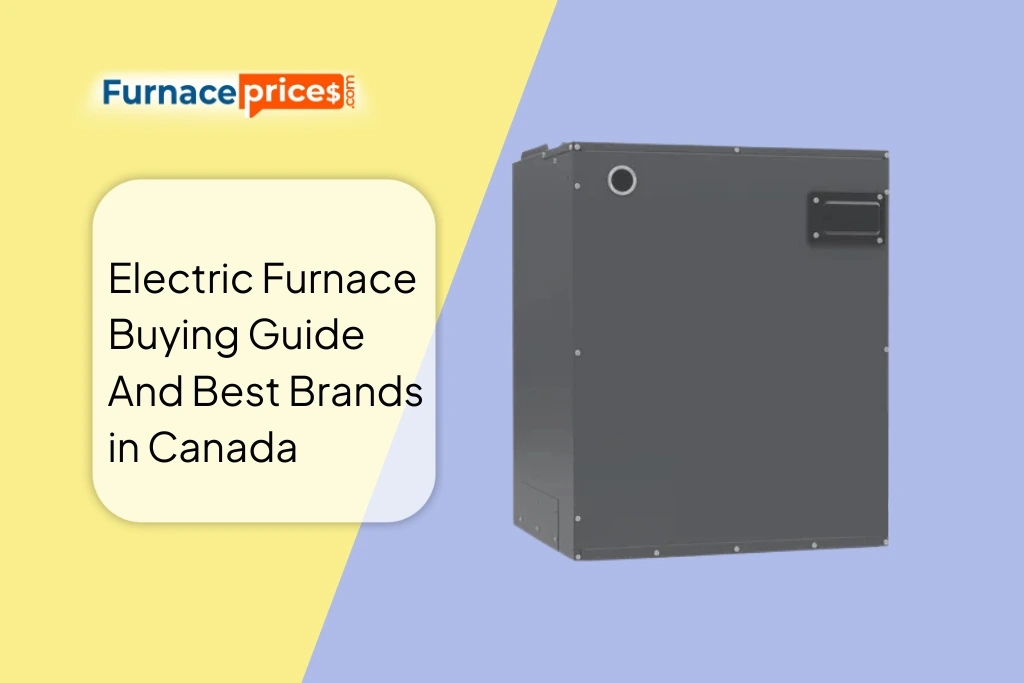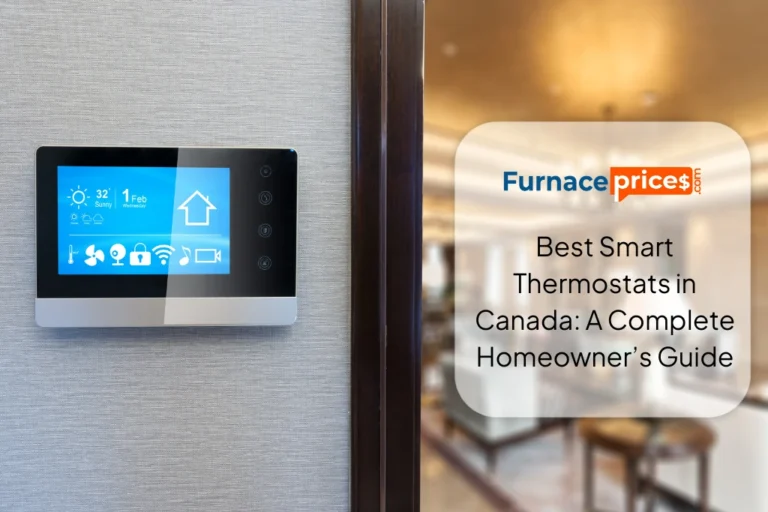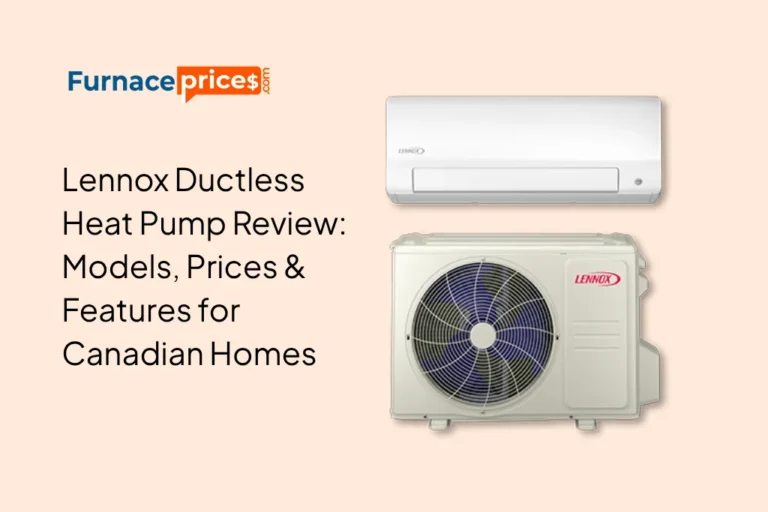Electric Furnace Buying Guide & Best Brands in Canada

Introduction
Electric furnaces have become an increasingly popular choice among Canadian homeowners—particularly in areas where natural gas service is limited. As highlighted in our Electric Furnace Buying Guide, they’re dependable, operate cleanly, and eliminate the need for fossil fuels.
This comprehensive guide explores how electric furnaces work, their benefits and limitations, leading brands available in Canada, and what you can expect to pay for purchase and installation. You’ll also learn when an electric furnace might make the most sense for your home and what factors to consider before buying one.
What Is an Electric Furnace and How Does It Work?
An electric furnace is a type of heating system that uses electrical resistance elements to produce heat. Instead of burning natural gas or propane like a conventional furnace, it converts electricity directly into thermal energy.
When your home’s temperature drops below the thermostat setting, an electrical signal activates the furnace. Power flows to the heating elements—typically metal coils made from nickel-chromium—which quickly heat up. A blower motor then pulls cool air from the return ducts, forces it over the hot elements, and circulates the warmed air back through the home’s ductwork.
Once the desired temperature is reached, the system shuts off automatically, though the fan may run briefly to distribute any remaining warm air — a feature commonly noted in our Electric Furnace Buying Guide.
According to Government of Canada recommendations, an electric furnace’s input rate should not exceed 65.92 kW (approximately 225,000 BTU/h) for safe and efficient operation.
Heating and Cooling with an Electric Furnace
While electric furnaces are primarily designed for heating, they can also be integrated into a combined heating and cooling setup.
In a split system, the furnace serves as the indoor air handler for both the heating and cooling process. It works in conjunction with an outdoor condenser (the air conditioner) to distribute cooled air in summer and heated air in winter. Although the furnace itself doesn’t cool the air, it plays a vital role in circulating conditioned air efficiently throughout your home.
Electric Furnace Sizes by Climate Zone
Choosing the right furnace size is essential for maintaining comfort and energy efficiency. As emphasized in our Electric Furnace Buying Guide, undersized furnaces struggle to keep up on cold days, while oversized units cycle on and off too often, wasting power.
Here’s a general guide to furnace output requirements across different climate zones in Canada:
| Home Size (sq ft) | Mild Climate (BTU/hr) | Moderate Climate (BTU/hr) | Cold Climate (BTU/hr) |
| 600 sq ft | 18,000 | 27,000 | 36,000 |
| 1,200 sq ft | 36,000 | 54,000 | 72,000 |
| 1,800 sq ft | 54,000 | 81,000 | 108,000 |
| 2,400 sq ft | 72,000 | 108,000 | 144,000 |
| 3,000 sq ft | 90,000 | 135,000 | 180,000 |
General BTU Guidelines:
- Mild climates: ~30 BTUs per sq ft
- Moderate climates: ~45 BTUs per sq ft
- Cold climates: ~60 BTUs per sq ft
These numbers may vary depending on your home’s insulation, window quality, and air leakage levels.
Electric Furnace Components Explained
Electric furnaces contain fewer moving parts than gas models, making them easier to maintain. Here’s a quick overview of their main components and functions:
- Thermostat: Monitors indoor temperature and signals the furnace to turn on or off as needed.
- Heating Elements: Metal coils that generate heat when electricity passes through them.
- Blower Motor: Circulates air throughout the duct system to maintain consistent warmth.
- Air Filter: Traps dust and debris, improving indoor air quality and protecting internal parts.
- Heat Exchanger: Transfers heat from the elements to the air while keeping airflow isolated from electrical components.
- Return Air Ducts: Draw cooler air back to the furnace for reheating.
- Supply Ducts: Deliver heated air to each room.
- Sequencer: Activates heating elements in stages to balance electrical load and prevent sudden power surges.
- Relays and Transformers: Control voltage flow and ensure safe electrical operation.
- Emergency Shut-Off Switch: Cuts power in the event of malfunction or overheating.
Best Electric Furnace Buying Guide: Furnace Brands in Canada
Not every HVAC manufacturer produces electric furnaces, but several reputable brands offer reliable models that perform well in Canadian climates. Our Electric Furnace Buying Guide highlights some of the most trusted names you can consider.
1. Goodman
Goodman produces durable, budget-friendly systems and also owns the Direct Comfort brand, which is sold primarily online. Despite being lower in cost, Direct Comfort furnaces share the same manufacturing standards and warranties as Goodman units.
Goodman electric furnaces range in capacity from about 10,000 to 68,000 BTUs, with typical lifespans of 15 to 30 years. Prices, including installation, generally fall between $3,600 and $5,000. Although efficiency can decline slightly after 15 years, their reliability and widespread parts availability make them a solid investment.
2. Trane
Trane’s electric heating lineup focuses on compact, wall-mounted unit heaters suitable for smaller areas or supplemental heating. Their units offer capacities from 5,000 to 16,000 BTUs per hour and weigh less than 30 pounds, making them lightweight and easy to install.
They’re known for offering pre-engineered, factory-installed control options that simplify setup. Trane remains a trusted brand for homeowners seeking space-saving electric heating solutions.
3. York
York’s electric furnaces appeal to cost-conscious buyers. Models typically cost $1,200 to $2,300 for equipment only or $2,600 to $7,400 with professional installation.
While not packed with advanced features, York furnaces are dependable and straightforward to operate—ideal for homeowners who want efficient, no-frills heating. York’s residential HVAC products are manufactured in Wichita, Kansas, ensuring quality control and consistent performance.
4. Dettson
Canadian manufacturer Dettson stands out for offering smaller-capacity modulating and two-stage electric furnaces—perfect for compact or energy-efficient homes. Their Chinook series can even be converted for propane use with a simple kit, providing flexibility for different energy sources.
Dettson backs its furnaces with a 10-year warranty on parts, reinforcing its commitment to quality and longevity.
5. Winchester
Winchester furnaces are another budget-friendly option, typically priced between $1,200 and $1,400. They feature a 5-year limited warranty and many models include an Electronically Commutated Motor (ECM) for constant torque and improved airflow efficiency.
This design supports 2- to 3.5-ton air conditioning or heat pump systems, making Winchester a versatile option for whole-home comfort.
How Much Does an Electric Furnace Cost in Canada?
The total cost of installing an electric furnace in Canada varies depending on factors like the unit type, home size, electrical capacity, and labour rates. As outlined in our Electric Furnace Buying Guide, here’s a breakdown of typical expenses:
| Component | Estimated Cost (CAD) | Notes |
| Mobile Home Furnace | $1,000 – $2,000 | Compact design for mobile or modular homes |
| High-Efficiency Furnace | $1,200 – $7,000 | Energy-saving models with improved airflow |
| Old Furnace Removal | $500 – $600 | Disposal and labour for safe removal |
| Ductwork Installation | $1,500 – $7,000 | Depends on home size and accessibility |
| Duct Cleaning (if needed) | Up to $500 | Improves air quality and system efficiency |
| Installation Labour | $50 – $100 per hour | Roughly 8 – 10 hours for most projects |
| Electrical Upgrades | $500 – $2,000 | May include new circuit, breaker, or wiring |
| Permits & Inspections | $100 – $500 | Required in some municipalities |
Electric vs. Gas Furnace Operating Costs
Although electric furnaces are 100% efficient at converting electricity into heat, electricity itself is generally more expensive than natural gas in most provinces.
For instance, producing the same heat output with electricity can cost up to 10 times more than with gas, depending on your utility rates. A mid-sized electric furnace operating 9 hours per day at 18,000 watts could add $500 to $1,000 per month to your hydro bill at Canada’s average $0.192 per kWh rate.
However, in provinces like Quebec, Manitoba, and British Columbia, where electricity is largely hydroelectric and competitively priced, operating costs can be much more reasonable.
Tips to Reduce Electric Heating Costs
- Improve insulation: Sealing leaks and adding insulation reduces energy loss.
- Use off-peak electricity: Some utilities offer discounted night rates.
- Install solar panels: Over time, renewable energy can offset higher electricity costs.
- Consider a heat pump: Heat pumps transfer existing heat rather than creating it, achieving efficiencies over 300%.
When Does an Electric Furnace Make Sense?
While gas furnaces dominate in many Canadian cities, electric furnaces can be the smarter option under certain conditions:
- No Gas Service Available: In remote regions or parts of Newfoundland, Labrador, and the territories where natural gas isn’t accessible, electric furnaces provide a practical heating solution.
- Eco-Friendly Goals: Homeowners in hydro-powered provinces can enjoy lower carbon emissions and cleaner energy.
- Lower Installation Costs: Without gas lines or exhaust vents, installation is often simpler and cheaper.
- Enhanced Safety: Electric systems eliminate risks of gas leaks and carbon monoxide exposure.
- Integrated Smart Homes: They pair easily with solar systems and future energy-efficient upgrades.
- Stable Electricity Rates: In regions where electricity costs remain low, the long-term operational difference can be minimal.
Key Factors When Choosing an Electric Furnace
1. Home Size (Square Footage)
The furnace size, measured in BTUs, should match your home’s heating load.
| Home Size (sq ft) | Recommended BTUs | Average Price Range (Installed) |
| Under 1,000 | ~40,000 | $700 – $3,000 |
| 1,000 – 1,500 | 40,000 – 55,000 | $1,000 – $3,500 |
| 1,500 – 2,000 | 50,000 – 70,000 | $1,200 – $4,000 |
| 2,000 – 2,500 | 70,000 – 90,000 | $1,700 – $4,500 |
| 2,500 – 3,500 | 90,000 – 100,000 | $1,900 – $5,000 |
Actual costs can vary depending on furnace efficiency, brand, and labour rates.
2. Airflow Capacity (CFM Rating)
CFM—short for Cubic Feet per Minute—indicates how much air the blower moves. The higher the CFM, the greater the furnace’s airflow capacity.
| Furnace CFM | Compatible AC Capacity |
| 1,200 CFM | 1.5 – 3 tons |
| 1,600 CFM | 3.5 – 4 tons |
| 2,000 CFM | 4 – 5 tons |
For example, a 4-ton AC requires about 1,600 CFM (400 CFM × 4 tons). Choosing a furnace with the right airflow ensures balanced comfort across heating and cooling seasons.
3. Type of Electric Heating System
Electric heating systems in Canada come in several forms:
- Forced-Air Systems: Use ducts to distribute warm air throughout the home.
- Hydronic (Hot Water) Systems: Rely on water heated by an electric boiler that circulates through radiators or underfloor piping.
- Room Heaters: Compact, standalone units ideal for small spaces.
- Radiant Heating: Provides gentle warmth from floors, walls, or ceilings—excellent for allergy-sensitive households.
- Combination Systems with Plenum Heaters: Add electric heating to an existing furnace system for hybrid operation.
4. Installation Location
Installation costs are influenced by where the furnace and ductwork are placed. Attics and basements are typically easier and cheaper to access than finished living spaces. When ducts must be installed behind drywall or ceilings, expect higher labour and material costs.
Get Personalized Electric Furnace Quotes
Ready to explore electric furnace options for your home?
At FurnacePrices.com, we make the process simple and transparent. You can compare prices, learn about efficiency ratings, and get free quotes from trusted, certified HVAC contractors in your area—with no pressure to commit.
We carefully vet every partner to ensure homeowners receive honest, professional advice.
Have questions about choosing the right electric furnace?
Visit FurnacePrices.com today to access expert resources, cost calculators, and local installation quotes—all designed to help you make confident heating decisions.
For more information on energy efficiency standards and incentives in Canada, visit Natural Resources Canada.
📞 Have questions? Contact us or email us at contact@furnaceprices.com.
✅ Start comparing today and make the right choice with confidence!







